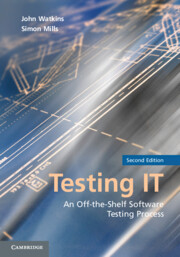Book contents
- Frontmatter
- Contents
- Foreword to the Second Edition by Geoff Thompson
- Foreword to the First Edition by Maurice Rosenburgh
- Acknowledgments
- 1 Introduction
- PART 1 THE TRADITIONAL TESTING PROCESS
- 2 An Overview of Testing
- 3 Testing Techniques
- 4 The Management and Planning of Testing
- 5 Unit Testing
- 6 Integration Testing
- 7 System Testing
- 8 Systems Integration Testing
- 9 User Acceptance Testing
- 10 Operations Acceptance Testing
- 11 Regression Testing
- 12 Improving the Testing Process
- 13 Introduction, Adoption, and Maintenance of the Testing Process
- 14 Agile Testing
- PART 2 THE TESTING PROCESS IN THE REAL WORLD: ILLUSTRATIVE CASE STUDIES
- PART 3 THE APPENDICES
- References
- Glossary
- Index
7 - System Testing
Published online by Cambridge University Press: 03 May 2011
- Frontmatter
- Contents
- Foreword to the Second Edition by Geoff Thompson
- Foreword to the First Edition by Maurice Rosenburgh
- Acknowledgments
- 1 Introduction
- PART 1 THE TRADITIONAL TESTING PROCESS
- 2 An Overview of Testing
- 3 Testing Techniques
- 4 The Management and Planning of Testing
- 5 Unit Testing
- 6 Integration Testing
- 7 System Testing
- 8 Systems Integration Testing
- 9 User Acceptance Testing
- 10 Operations Acceptance Testing
- 11 Regression Testing
- 12 Improving the Testing Process
- 13 Introduction, Adoption, and Maintenance of the Testing Process
- 14 Agile Testing
- PART 2 THE TESTING PROCESS IN THE REAL WORLD: ILLUSTRATIVE CASE STUDIES
- PART 3 THE APPENDICES
- References
- Glossary
- Index
Summary
“The process of system testing is like removing the needles from the haystack without disturbing the straws”
Overview
The objective of system testing is to establish confidence that the application under test (AUT) will be accepted by its users (and/or operators), that is, that it will pass its acceptance tests. During system testing, the functional and structural stability of the system will be demonstrated, as well as nonfunctional requirements such as performance and reliability. System testing is conducted by the testing team under the supervision of the test team leader.
Where the AUT has a moderate requirement to interoperate with one or more collaborating software systems, this may be tested during systems testing. Where the AUT has a significant requirement to interoperate with several collaborating software systems and/or the nature of the interoperation is complex, this will typically be tested during a separate testing phase – termed systems integration testing (see Chapter 8 for further details).
System testing should employ black box testing techniques and will test high-level requirements of the system without considering the implementation details of component modules (e.g., performing thread testing and/or testing complete transactions).
In terms of the V Model, system testing corresponds to the specification phase of the software development lifecycle (see Figure 7.1).
Testing issues associated with system testing (such as test planning and resourcing and the review of testing requirements and high-level test design), should be considered during the specification phase of system development.
- Type
- Chapter
- Information
- Testing ITAn Off-the-Shelf Software Testing Process, pp. 63 - 69Publisher: Cambridge University PressPrint publication year: 2010



